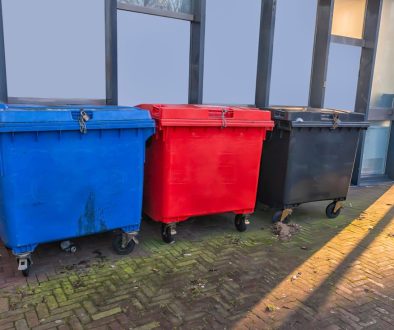From industrial facilities to retail spaces, businesses across various sectors often handle hazardous waste materials that can pose risks to the environment, employees, and the public. As a family-run skip hire and aggregate company servicing Staffordshire, we recognise the challenges faced by businesses when dealing with hazardous waste and are committed to sharing our expertise to help you navigate safe storage practices.
In this comprehensive guide, we will explore the essential aspects of hazardous waste storage, discussing the importance of risk assessment, the use of appropriate containment systems, and practical tips for maintaining compliance with regulations. Our goal is to provide businesses with the knowledge they need to safely store hazardous waste materials, protecting employees, the general public, and the environment from potential harm.
As leaders in waste management, we understand that managing hazardous waste can be a daunting process, especially when striving to adhere to constantly evolving regulations and guidelines. That’s why we offer expert advice and resources, including information on the safe storage and disposal of hazardous waste materials, to help businesses make informed decisions based on best practices. Together, we can promote a cleaner, healthier environment while safeguarding staff and the communities we serve.
Understanding how to safely store hazardous waste materials not only protects your employees and reduces your business’s liability but also contributes to a more sustainable future for our planet. By partnering with professionals like us, you can access the resources and expertise needed to manage hazardous waste effectively, allowing you to focus on what you do best – running your business.
1. Conducting a Comprehensive Risk Assessment
The foundation of effective hazardous waste storage is a thorough risk assessment, which helps businesses identify potential risks and establish appropriate controls. A comprehensive risk assessment should include:
– Identifying hazardous waste materials: Begin by determining the types of hazardous waste materials your business generates, stores, or handles, considering factors like chemical composition, physical and chemical properties, and potential hazards.
– Evaluating storage requirements: Assess the storage needs for each hazardous waste type, including volumes, container types, containment systems, and segregation requirements based on compatibility.
– Identifying potential risk areas: Review your site’s layout, workflows, and operating procedures to pinpoint areas where hazardous waste materials could pose a risk to employees, the environment, or equipment.
– Establishing controls: Develop and implement measures to mitigate identified risks, such as proper storage, containment systems, and employee training.
2. Utilising Appropriate Containment Systems
Containment systems are crucial in preventing hazardous waste leaks, spills, and contamination. The choice of containment system will depend on the type of hazardous waste and the volume being stored. Consider the following options:
– Designated containers: Use containers specifically designed to hold and protect the hazardous waste materials they contain. Containers should be compatible with the waste being stored and suitable for the material’s properties and hazards.
– Secondary containment: Install secondary containment systems, such as bunds, drip trays, or pallets, to capture leaks or spills and prevent contamination of the surrounding environment.
– Segregation of incompatible materials: Keep incompatible hazardous wastes separate by using different storage areas or barriers to reduce the risk of cross-contamination or adverse reactions.
– Ventilation and temperature controls: Implement proper ventilation systems to prevent the build-up of hazardous fumes, and maintain appropriate temperature conditions to prevent fires or explosions.
3. Regular Inspections and Maintenance
Routine inspections and maintenance are vital for ensuring the safety and integrity of your hazardous waste storage facilities, assessing potential risks and identifying areas for improvement. Consider the following best practices:
– Create inspection schedules: Develop a timetable for regular inspections, with more frequent checks for high-risk materials or storage areas.
– Train inspection personnel: Provide thorough training for staff responsible for inspecting hazardous waste storage facilities, ensuring they understand the hazards and the necessary safety procedures.
– Document inspection findings: Maintain detailed records of inspection results, including identifying any issues, implementing corrective actions, and noting any changes to storage requirements or materials.
– Review and update procedures: Regularly assess and update your hazardous waste storage protocols based on inspection findings, changes in regulations, or new information on waste material hazards.
4. Ensuring Compliance with Regulations and Guidelines
Adherence to relevant regulations and guidelines is essential for maintaining a safe and compliant hazardous waste storage system. To ensure regulatory compliance, businesses should:
– Stay informed: Keep up to date with regulatory changes and guidelines relevant to your industry and the hazardous waste materials you store or manage.
– Maintain documentation: Keep accurate records of all hazardous waste materials on-site, as well as inventory logs, risk assessments, inspection reports, and any relevant permits or licences.
– Implement employee training: Train staff involved in handling hazardous waste materials on the proper storage, containment, and disposal practices, as well as recognising potential hazards and emergency response procedures.
– Collaborate with waste management professionals: Work with expert waste management partners to help you navigate the complexities of hazardous waste storage, ensuring your business maintains compliance and minimises environmental impact.
Conclusion
Implementing best practices for hazardous waste storage is a critical responsibility for businesses handling potentially harmful materials. By conducting comprehensive risk assessments, utilising appropriate containment systems, maintaining regular inspections, and following regulations and guidelines, your business can mitigate risks to employees, the environment, and public health.
If you require support in managing hazardous waste storage and disposal, we are here to help. At Enviro Skip Hire, our team of experts can provide valuable advice and resources to ensure your business adheres to best practices and stays compliant with regulations. Contact us today to learn more about our waste management services and how we can support your business’s hazardous waste management needs.




